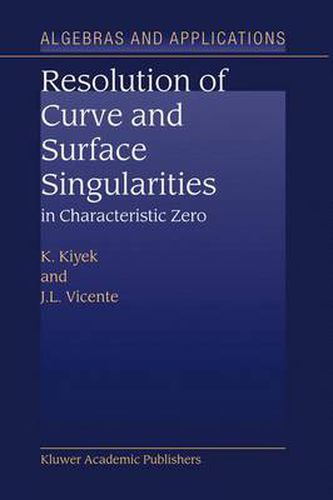Readings Newsletter
Become a Readings Member to make your shopping experience even easier.
Sign in or sign up for free!
You’re not far away from qualifying for FREE standard shipping within Australia
You’ve qualified for FREE standard shipping within Australia
The cart is loading…






This title is printed to order. This book may have been self-published. If so, we cannot guarantee the quality of the content. In the main most books will have gone through the editing process however some may not. We therefore suggest that you be aware of this before ordering this book. If in doubt check either the author or publisher’s details as we are unable to accept any returns unless they are faulty. Please contact us if you have any questions.
The Curves The Point of View of Max Noether Probably the oldest references to the problem of resolution of singularities are found in Max Noether’s works on plane curves [cf. [148], [149]]. And probably the origin of the problem was to have a formula to compute the genus of a plane curve. The genus is the most useful birational invariant of a curve in classical projective geometry. It was long known that, for a plane curve of degree n having l m ordinary singular points with respective multiplicities ri, i E {1, … , m}, the genus p of the curve is given by the formula = (n - l)(n - 2) _ ~ r. (r. _ 1) P 2 2 L. . ,. ** . Of course, the problem now arises: how to compute the genus of a plane curve having some non-ordinary singularities. This leads to the natural question: can we birationally transform any (singular) plane curve into another one having only ordinary singularities? The answer is positive. Let us give a flavor (without proofs) 2 on how Noether did it * To solve the problem, it is enough to consider a special kind of Cremona trans formations, namely quadratic transformations of the projective plane. Let ~ be a linear system of conics with three non-collinear base points r = {Ao, AI, A }, 2 and take a projective frame of the type {Ao, AI, A ; U}.
$9.00 standard shipping within Australia
FREE standard shipping within Australia for orders over $100.00
Express & International shipping calculated at checkout
This title is printed to order. This book may have been self-published. If so, we cannot guarantee the quality of the content. In the main most books will have gone through the editing process however some may not. We therefore suggest that you be aware of this before ordering this book. If in doubt check either the author or publisher’s details as we are unable to accept any returns unless they are faulty. Please contact us if you have any questions.
The Curves The Point of View of Max Noether Probably the oldest references to the problem of resolution of singularities are found in Max Noether’s works on plane curves [cf. [148], [149]]. And probably the origin of the problem was to have a formula to compute the genus of a plane curve. The genus is the most useful birational invariant of a curve in classical projective geometry. It was long known that, for a plane curve of degree n having l m ordinary singular points with respective multiplicities ri, i E {1, … , m}, the genus p of the curve is given by the formula = (n - l)(n - 2) _ ~ r. (r. _ 1) P 2 2 L. . ,. ** . Of course, the problem now arises: how to compute the genus of a plane curve having some non-ordinary singularities. This leads to the natural question: can we birationally transform any (singular) plane curve into another one having only ordinary singularities? The answer is positive. Let us give a flavor (without proofs) 2 on how Noether did it * To solve the problem, it is enough to consider a special kind of Cremona trans formations, namely quadratic transformations of the projective plane. Let ~ be a linear system of conics with three non-collinear base points r = {Ao, AI, A }, 2 and take a projective frame of the type {Ao, AI, A ; U}.